Abstract
The lengths of certain passage-time intervals (random time intervals) in discrete-event stochastic systems correspond to delays in computer, communication, manufacturing, and transportation systems. Simulation is often the only available means for analyzing a sequence of such lengths. It is sometimes possible to obtain meaningful estimates for the limiting average delay indirectly, that is, without measuring lengths of individual passage-time intervals. For general time-average limits of a sequence of delays, however, it is necessary to measure individual lengths and combine them to form point and interval estimates. We consider sequences of delays determined by state transitions of a generalized semi-Markov process and introduce a recursively-generated sequence of realvalued random vectors, called start vectors, to provide the link between the starts and terminations of passage-time intervals. This method of start vectors for measuring delays avoids the need to “tag” entities in the system. We show that if the generalized semi-Markov process has a recurrent single-state, then the sample paths of any sequence of delays can be decomposed into one-dependent, identically distributed cycles. We then show that an extension of the regenerative method for analysis of simulation output can be used to obtain meaningful point estimates and confidence intervals for time-average limits. This estimation procedure is valid not only when there are no ongoing passage times at any regeneration point but, unlike previous methods, also when the sequence of delays does not inherit regenerative structure. Application of these methods to a manufacturing cell with robots is discussed.
Similar content being viewed by others
References
Asmussen, S. 1987.Applied Probability and Queues. New York: John Wiley.
Crane, M. A. and Iglehart, D. L. 1975. Simulating stable stochastic systems: III, regenerative processes and discrete event simulation.Oper. Res. 23: 33–45.
Fox, B. L. and Glynn, P. W. 1987. Estimating time averages via randomly-spaced observations.SIAM J. Appl. Math. 47: 186–200.
Glynn, P. W. 1982. Simulation output analysis for general state space Markov chains. Ph. D. Dissertation. Department of Operations Research. Stanford University, Stanford, CA.
Glynn, P. W. 1983. On the role of generalized semi-Markov processes in simulation output analysis.Proc. ACM 1983 Winter Simulation Conference S. Roberts, J. Banks, and B. Schmeiser (Eds). Arlington, VA, pp. 39–42. IEEE Catalog Number 83CH1593-9.
Glynn, P. W. 1994. Some topics in regenerative steady-state simulation.Acta Appl. Math. 34: 225–236.
Glynn, P. W. and Iglehart, D. L. 1989. Smoothed limit theorems for equilibrium processes.Probability, Statistics, and Mathematics: Papers in Honor of Samuel Karlin. T. W. Anderson, K. B. Athreya, and D. L. Iglehart (Eds.), New York: Academic Press.
Glynn, P. W. and Whitt, W. 1986. A central-limit-theorem version ofL=λW.Queueing Systems: Theory and Applications 2: 191–215.
Glynn, P. W. and Whitt, W. 1992. The asymptotic efficiency of simulation estimators.Oper. Res. 40: 505–520.
Gut, A. 1988.Stopped Random Walks: Limit Theorems and Applications. New York: Springer-Verlag.
Haas, P.J. 1985. Recurrence and regeneration in non-Markovian simulations. Ph. D. Dissertation. Department of Operations Research. Stanford University, Stanford, CA.
Haas, P. J. and Shedler, G. S. 1985. Regenerative simulation methods for local area computer networks.IBM J. Res. Develop. 29: 194–205.
Haas, P. J. and Shedler, G. S. 1987a. Recurrence and regeneration in non-Markovian networks of queues.Comm. Statist. Stochastic Models 3: 29–52.
Haas, P. J. and Shedler, G. S. 1987b. Regenerative generalized semi-Markov processes.Comm. Statist. Stochastic Models 3: 409–438.
Haas, P. J. and Shedler, G. S. 1989. Stochastic Petri nets with timed and immediate transitions.Comm. Statist. Stochastic Models 5: 563–600. (Special Issue Devoted to Computer-Experimental Methods in Probability.)
Haas, P. J. and Shedler, G. S. 1992. Simulation methods for manufacturing systems using stochastic Petri nets. Tech. Report RJ 8672. IBM Almaden Research Center. San Jose, CA.
Haas, P. J. and Shedler, G. S. 1993a. Passage times in colored stochastic Petri nets.Comm. Statist. Stochastic Models 9: 31–79.
Haas, P. J. and Shedler, G. S. 1993b. Estimation of passage times via equilibrium processes with one-dependent cycles. Tech. Report RJ 9520. IBM Almaden Research Center, San Jose, CA.
Iglehart, D. L. and Shedler, G. S. 1980.Regenerative Simulation of Response Times in Networks of Queues.Lecture Notes in Control and Information Sciences. Vol. 26. New York: Springer-Verlag.
Iglehart, D. L. and Shedler, G. S. 1983. Simulation of non-Markovian systems.IBM J. Res. Develop. 27: 472–480.
Iglehart, D. L. and Shedler, G. S. 1984. Simulation output analysis for local area computer networks.Acta Informatica 21: 321–338.
König, D., Matthes, K., and Nawrotzki, K. 1967.Verallgemeinerungen der Erlangschen und Engsetschen Formeln. Akademie-Verlag. Berlin.
König, D., Matthes, K., and Nawrotzki, K. 1974. Unempfindlichkeitseigenshaften von Bedienungsprozessen. Appendix to B. V. Gnedenko and I. N. Kovalenko,Introduction to Queueing Theory, German edition. Berlin: Akademie-Verlag.
Matthes, K. 1962. Zur Theorie der Bedienungsprozessen.Trans. 3rd Prague Conference on Information Theory and Statistical Decision Functions. Prague, Czechoslovakia.
Prisgrove, L. A. and Shedler, G. S. 1986. Symmetric stochastic Petri nets.IBM J. Res. Develop. 30: 278–293.
Ross, S. M. 1983.Stochastic Processes. New York: Wiley.
Shedler, G. S. 1987.Regeneration and Networks of Queues. Applied Probability Series. Berlin, Heidelberg, New York: Springer-Verlag.
Shedler, G. S. 1993.Regenerative Stochastic Simulation. Statistical Modeling and Decision Science Series. Boston, San Diego, New York: Academic Press.
Viswanadham, N. and Narahari, Y. 1988. Stochastic Petri net models for performance evaluation of automated manufacturing systems.Information and Decision Technologies 14: 125–142.
Whitt, W. 1980. Continuity of generalized semi-Markov processes.Math. Oper. Res. 5: 494–501.
Author information
Authors and Affiliations
Rights and permissions
About this article
Cite this article
Haas, P.J., Shedler, G.S. Estimation methods for passage times using one-dependent cycles. Discrete Event Dyn Syst 6, 43–72 (1996). https://doi.org/10.1007/BF01796783
Issue Date:
DOI: https://doi.org/10.1007/BF01796783




